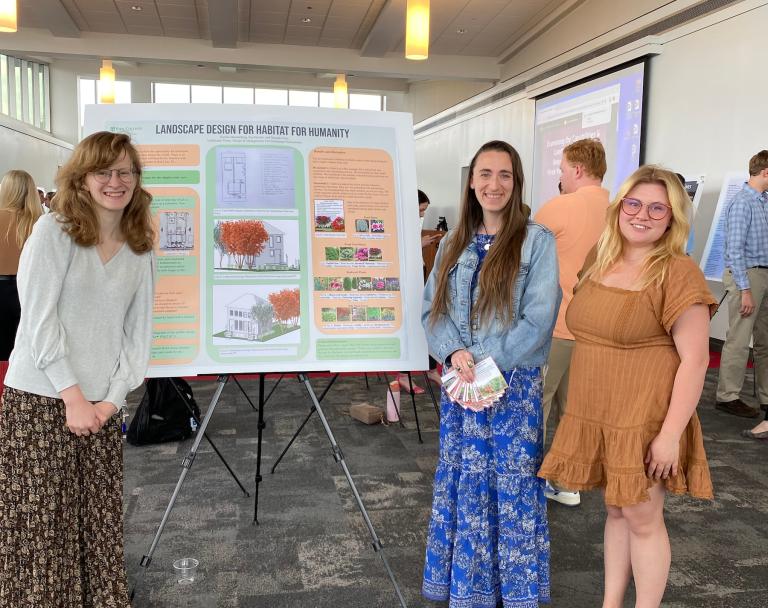
York College of Pennsylvania students tailored the plans to the desires of two families who will move into new houses in Red Lion, PA.
Community outreach and project-based learning go hand in hand in York College of Pennsylvania’s Appell Environmental Horticulture Program. Students have spent the Spring 2024 semester working with York Habitat for Humanity to design landscapes that reflect the hopes and dreams of two families preparing to move into Habitat homes and embark on a new chapter of their lives.
Under the guidance of AnaLu MacVean, Instructor of Environmental Horticulture, three juniors who will graduate in 2025—Kaitlin Dannenberg (Mechanicsburg, PA), Vie Meyers (York, PA), and Hannah Zinn (White Hall, MD)—spearheaded a project that pairs learning and community service. Their mission was to design the landscapes for two Habitat for Humanity homes in Red Lion, PA, working with the future homeowners to ensure that the plans reflect their desires and needs.
‘Every Family Is A... Different World'
MacVean’s students embraced this endeavor as an opportunity not only to hone their landscape design skills but to engage in meaningful community service.
“This is perfect because it’s a way of helping somebody while working through the process of landscape design,” MacVean says.
The women who will inhabit these homes became the students’ clients, making known their preferences and aspirations to guide the design process. From initial brainstorming sessions to making the final touches, the students navigated real-world client interactions, a valuable experience for their future careers.
“I really enjoyed working with the clients but also getting experience with landscape design,” Hannah says.
The two houses will form a duplex, and each family’s space brought special challenges. One woman is an avid gardener and wanted an abundance of plants, while the other has little experience tending a landscape. One house will have a detached garage, one will not, and the family in the latter home opted to add a pond to its yard. One family has a dog, the other doesn’t, and both have multiple young children.
Each variation created an array of topics to consider as the students designed the neighboring landscapes. What plants are toxic to dogs? Did the children have any allergies or were there other concerns? How could the students make sure the designs were safe for children? Would the spaces be shaded or sunny? Did the two families want privacy or connection across their properties?
“Every family is a whole little different world,” says MacVean.
After conferring with the homeowners, each student created landscape designs for both homes and presented them in class. Class members narrowed the choices to two collaborative designs, which were presented to the Habitat clients. After getting the homeowners’ input, the students put together a final bubble diagram.
Each student brought a different talent to the table, from conceptualizing designs to creating three-dimensional renderings to preparing information about how to care for the selected plants. Their collaboration was not just about pooling individual skills but learning to work harmoniously as a team, a vital lesson for their future professional endeavors, MacVean points out.
Fostering Community Connections
Representing the group, Kaitlin presented their designs at the 2024 Undergraduate Research Live Presentation Contest on April 24. Earlier in the spring they had presented their work at the Undergraduate Research Fair, where they were chosen as one of six teams to present at the follow-up competition for the chance to win a prize.
This endeavor was more than just an academic exercise. It fostered lasting connections in the community. For Kaitlin, the highlight has been “seeing how excited the clients are to be getting new homes that have been landscaped just for them. This was a genuinely rewarding experience, and I hope Habitat for Humanity includes our program in future builds.”
Similarly, for Vie the highlight was “the knowledge that something we designed will come to fruition and make families happy.”
With the designs complete, MacVean hopes the houses will be constructed in time for her students to be involved in the installation of the landscapes they fashioned. When the families settle into their new homes, they’ll do so knowing that their exterior surroundings have been crafted with care and consideration, tailored to their individual lifestyles and preferences.
MacVean says this project has given her students the skills and confidence to thrive in their chosen field not just as landscape designers but as catalysts for change in a community.
“These projects better equip them to go into the workforce and be confident that they can do this,” she says. “I hope people understand that our program also wants to participate in the community. We want to help as much as we can to solve small problems. It’s a win-win.”
The Environmental Horticulture program is funded through the Powder Mill Foundation and was a gift from the late York businessman and philanthropist Louis Appell Jr. The Appell family adored plants and loved York, MacVean notes. Having York College students provide landscape designs to organizations such as Habitat for Humanity reflects the Appells’ generosity toward the community they loved.
“It’s wonderful that we received this beautiful gift of being able to educate future generations. We have a responsibility to encourage our students to give back,” MacVean says. “It comes full circle.”




